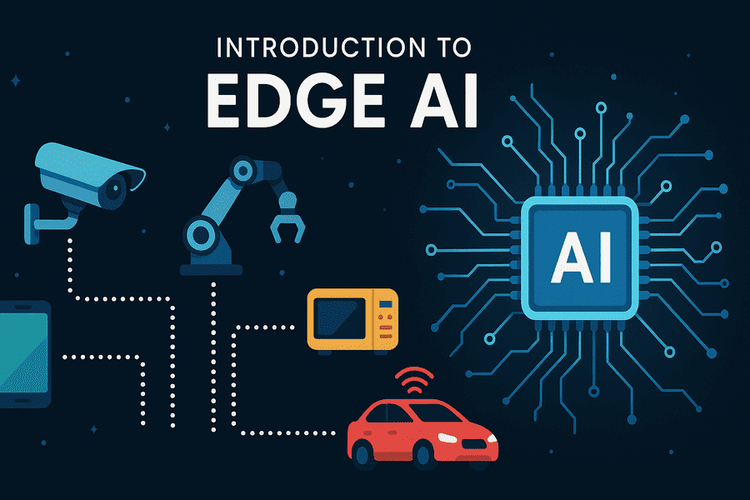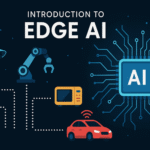Edge Artificial Intelligence (AI) has become the backbone of modern technology, powering applications from recommendation systems on Netflix to self-driving cars. Traditionally, AI systems relied on cloud computing-where data is sent to distant servers, processed, and returned to the device. But now, a new approach called Edge AI is transforming how we use technology by bringing intelligence directly to the devices we interact with daily.
This shift is not just a technical improvement-it represents a revolution in speed, privacy, and accessibility.

What is Edge Artificial Intelligence?
Edge AI combines artificial intelligence with edge computing, which means processing data closer to where it is generated (on devices like smartphones, IoT sensors, drones, or cameras) instead of sending it to a central cloud server.
For example:
- When your smartphone uses face recognition to unlock instantly, it’s Edge AI at work.
- Smart home devices that detect voice commands without sending recordings to the cloud are also powered by Edge AI.
Why Edge Artificial Intelligence Matters
- Speed and Real-Time Processing
Cloud-based AI introduces latency because data has to travel back and forth between the device and server. Edge AI eliminates this delay by processing information locally. This is critical for applications like self-driving cars or healthcare monitoring, where decisions must be made in milliseconds. - Improved Privacy
With Edge AI, sensitive data such as images, health records, or personal voice commands don’t need to leave your device. This ensures stronger data protection and user privacy-something increasingly important in an age of data breaches and surveillance concerns. - Reduced Bandwidth Usage
Sending massive amounts of data to cloud servers requires high bandwidth and can be expensive. Edge AI reduces this demand by filtering and processing only the necessary data locally. - Reliability
Devices powered by Edge AI can function even with poor or no internet connectivity. This makes them highly reliable in remote or disaster-prone areas.
Real-World Applications of Edge Artificial Intelligence
- Healthcare
- Wearable devices like smartwatches use Edge AI to monitor heart rates, oxygen levels, and sleep patterns in real-time.
- In hospitals, smart monitoring systems analyze patient data instantly to detect early warning signs of health issues.
- Autonomous Vehicles
- Self-driving cars rely on Edge AI to process sensor and camera data instantly. A cloud delay of even a few seconds could mean accidents, so local processing is essential.
- Smart Homes
- Voice assistants like Alexa or Google Home increasingly use Edge AI to process commands locally, reducing reliance on the internet and ensuring faster responses.
- Retail and Shopping
- Smart checkout systems analyze products and customer behavior on-site, enabling cashier-less stores like Amazon Go.
- Security and Surveillance
- Cameras equipped with Edge AI can identify unusual activity, detect faces, or recognize license plates instantly without needing a central server.
- Manufacturing and Industry
- Factories deploy Edge AI to monitor equipment, predict failures, and maintain efficiency in real-time (a concept known as predictive maintenance).
The Benefits of Edge Artificial Intelligence
- Faster performance due to reduced latency.
- Stronger privacy protections since data stays on the device.
- Cost savings through lower bandwidth and cloud storage needs.
- Scalability, as millions of IoT devices can run AI without overloading centralized servers.
- Energy efficiency, since less data is transmitted over networks.
Challenges of Edge Artificial Intelligence
While promising, Edge AI is not without its challenges:
- Hardware Limitations
Devices must be powerful enough to run AI models, which often require significant computing power. Chip makers like NVIDIA, Intel, and Qualcomm are addressing this with specialized processors. - Model Optimization
AI models need to be compressed and optimized to run efficiently on small devices without losing accuracy. - Security Risks
Although Edge AI improves privacy, devices themselves can be hacked. Strong cybersecurity is essential to prevent unauthorized access. - Integration Complexity
Deploying Edge AI across industries requires careful planning, especially when combining old infrastructure with new technology.
The Future of Edge Artificial Intelligence
The future looks incredibly promising for Edge AI:
- 5G networks will complement Edge AI by offering faster connectivity, enabling more complex real-time applications.
- AI chips designed specifically for edge devices will make processing faster and more energy-efficient.
- Smart cities will leverage Edge AI for managing traffic, waste, and public safety more efficiently.
- Healthcare innovation will accelerate, with wearable tech becoming essential for monitoring chronic diseases and early diagnosis.
According to market research, the global Edge AI market is projected to grow to over $100 billion by 2030, making it one of the fastest-growing sectors in technology.
Conclusion
Edge AI is reshaping how we think about artificial intelligence by moving it away from distant cloud servers and placing it directly in our pockets, homes, and workplaces. With its ability to provide real-time decision-making, enhanced privacy, and reduced costs, it is becoming a cornerstone of the digital future.
From self-driving cars and healthcare wearables to smart homes and industrial automation, Edge AI is proving to be not just a technological trend, but a fundamental shift in how intelligence is applied in our daily lives.
As the world moves toward a more connected and data-driven future, Edge AI stands out as the innovation that bridges the gap between humans, machines, and the information age-bringing intelligence closer than ever before. Also Check Cryptocurrency mining – Comprehensive Guide – 2025



1 thought on “Edge Artificial Intelligence – Detailed Guide – 2025”